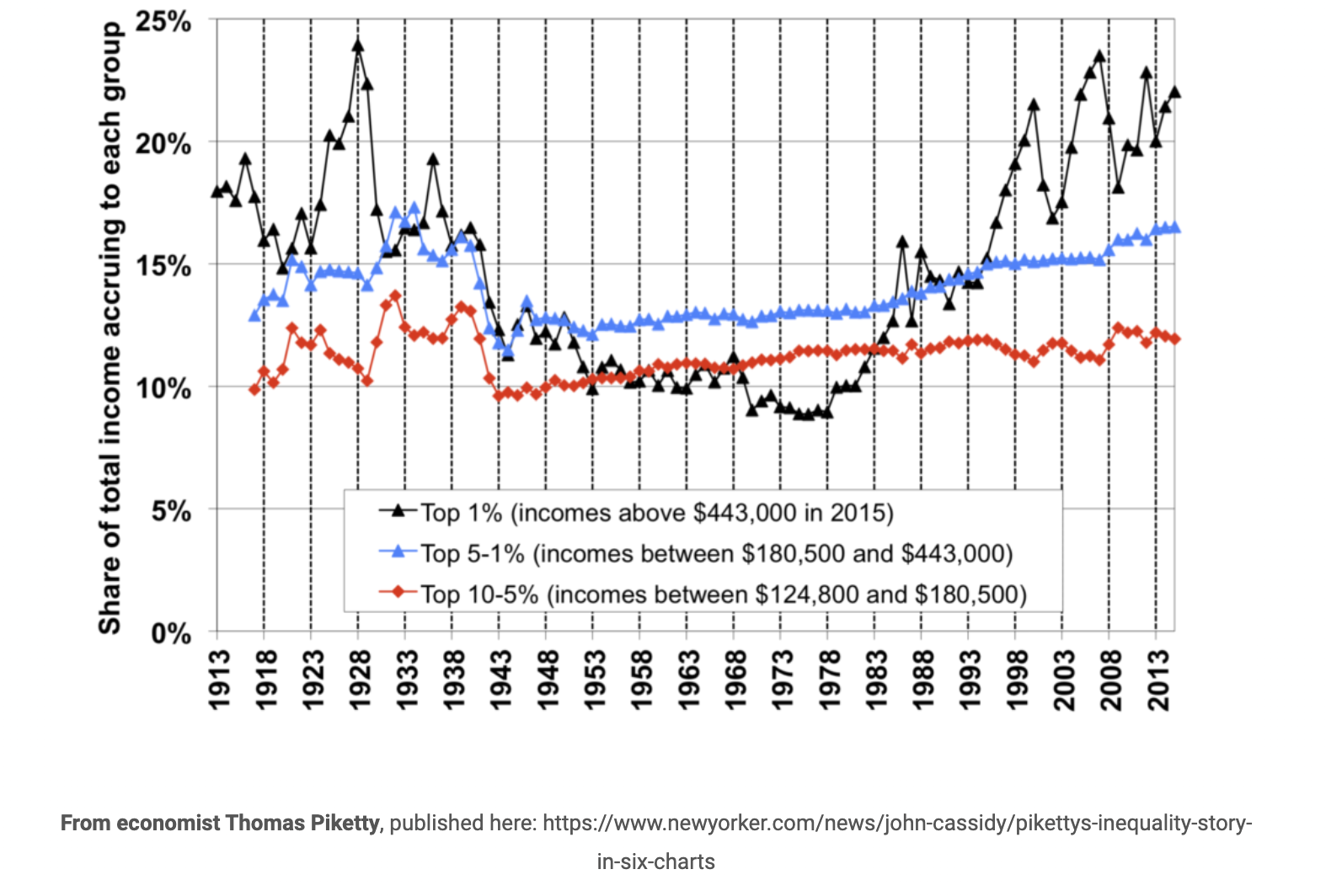I have heard the Build Back Better, American Rescue Act, and Bipartisan Infrastructure Deals talked about from a few angles.
They’ve mostly been discussed in the media from the viewpoint of the grueling process of passing major legislation with razor-thin majorities. They’ve also been talked about as Democratic “wins” in the context of whether this will help Democrats in the midterms.
I haven’t seen much discussion of the long-term effects of this legislation.
I’ll start with this truth: Democracy doesn’t work when there is too much income inequality.
In this article, Oren M. Levin-Waldman talks about how (and why) income inequality threatens democracy. Obviously, if money can buy politicians, major networks, and otherwise control the legislative decision-making, democracy is in danger. There are other ways too much income inequality is a threat. Democratic theory assumes a society of free, equal, and autonomous individuals. If you can’t leave your job because you need the health care benefits, you are not free. If certain groups are unable to take time from work to vote, or if they have no time to become educated about issues, or if they lack access and the ability to participate, democracy is in danger. Too much income inequality often leads to unrest and resentment. People who are in pain because they are sick without access to health care or unemployed are more vulnerable to demagogues and rage-merchants. When large numbers of people sink too deeply into poverty, they can become cut off from the rest of society.
You get the idea.
I’ve often quoted this chart from Thomas Picketty:
Here’s another from Pew Research:
One of historian Heather Cox Richardson’s insights is that democracy is always in danger of slipping toward oligarchy because those in power sometimes (but not always) advance policies and legislation that helps them get richer, which increases the income divide until you have an oligarchy (a relatively few people with almost all the power).
She also says we’ve had two oligarchies in our history. Before the Civil War, 1% of the population, Southern slaveowners, largely controlled all three branches of government and much of the nation’s wealth. We had our second oligarchy during the age of robber barons, from the late nineteenth century until the New Deal. Power was concentrated in the hands of a few wealthy white men, mostly business tycoons but also families that had accumulated wealth.
The second oligarchy is reflected in the first spike in the Picketty chart. Income levels evened out a bit in the 1950s (although Blacks were still largely left out.)
Then, by the 1980s, when Reagan’s economic policies began going into effect, income inequality began opening up again. As of 2008, we were at 1920s levels. As of 2018, levels were rising again.
As of the 2020 election, we were tipping into our third oligarchy. Had Trump won the election, one of the many ways our democracy may have been ruptured would have been Trump to continue his policies of tax cuts for the rich and taking away benefits (like trying to take away health care), which would have caused income inequality levels to open up even farther, putting democracy in greater danger.
Here is where Biden’s three major pieces of legislation (the American Rescue Plan, the Bipartisan Infrastructure Deal, and Build Back Better) come in.
The press focused on the grueling process of getting three major bills passed. I think it’s worthwhile to reflect on the far-reaching implications of these bills.
The American Rescue Plan Act of 2021, nutshell, is building equitable economic recovery and reducing child poverty. A Columbia University study found that the bill will lift more than 5 million children out of poverty this year, cutting the poverty rate by 50%. The bill offers more than two-thirds of its tax cuts and direct payments going to families making less than $90,000 per year. It provided cash to families, extended unemployment insurance, helped prevent people from being evicted because they were unable to pay their rent, and much more, which you can see here.
The Bipartisan Infrastructure Deal, among other things, is a job creation plan that will rebuild communities. It will help clean up dirty water, bring internet to rural areas and low-income areas, and address climate change. You can see more here.
Build Back Better is the third piece of legislation that is on its way. It provides, among other things, that middle-class families will pay no more than 7% of their income on child care. It invests in child care and pre-K (which obviously helps working families and prepares all children for kindergarten). It reduces the cost of health care, creates low-income housing, and helps seniors get the care they need.
These bills are reminiscent of Franklin Delano Roosevelt’s New Deal. In fact, a humorous moment occurred during Kevin McCarthy’s 90 minutes diatribe when McCarthy said “Nobody elected Joe Biden to be FDR,” and Alexandria Ocasio-Cortez shouted, “I DID!”
After the 1930s, conservatives spent decades trying to undo the New Deal. While they managed to roll some of it back, they’ve learned that it’s difficult to take away benefits once people get used to them. That’s why we still have social security and other benefits from the New Deal.
Biden’s bills will help even out income inequality, thereby pulling us back from a dangerous precipice.
Yes, there’s still a long way to go, but let’s not underestimate the importance of these bills.







